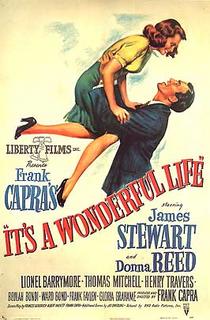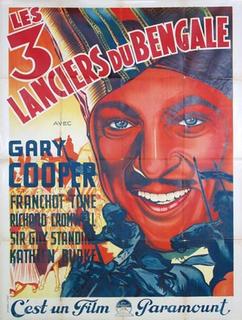It's a Wonderful Life
 Arguably the most beloved holiday classic of all time, this is a movie that is unfairly lumped into cynic's "overrated" lists because of the vague imprints this movie has left on even the least movie savvy of peoples' minds. Annual airings on television have insured that this movie is part of pop culture society whether you like it or not, and whether you and whether you know it or not. Thanks to the film's rights lapsing into public domain (due to the dissolution of the film's company, Liberty Pictures, a failed noble venture by directors Frank Capra, George Stevens and William Wyler) any television station that wanted to could air this film during the holidays. Unfortunately now people see it as some kind of joke, a film remembered more for people vaguely remembering it always being on once a year, but not for the actual film itself. It is true, the movie is pure cinematic corn, sweet to the core, and is easy fodder for contemporary cynics to tear apart. But there is also a great story here, and a great cast, led by Frank Capra's go-to "everyman" Jimmy Stewart as "everyman"George Bailey, the guy who sacrifices everything for his family, in the process not realizing how many lives he's touched. Capra's moving Christmas card is aided immensely by the presence of screen veterans like Lionel Barrymore as the evil Mr. Potter (the most intimidating man in a wheelchair ever!) and Thomas Mitchell as forgetful Uncle Billy. The screen also shines courtesy of the radiant Donna Reed in her screen debut as George's sweetheart Mary. Under the sure-handed direction of Capra, marking the first film he and Jimmy Stewart both made after their time spent in World War II, this is a film that deserves to be recognized more than just once a year.
Arguably the most beloved holiday classic of all time, this is a movie that is unfairly lumped into cynic's "overrated" lists because of the vague imprints this movie has left on even the least movie savvy of peoples' minds. Annual airings on television have insured that this movie is part of pop culture society whether you like it or not, and whether you and whether you know it or not. Thanks to the film's rights lapsing into public domain (due to the dissolution of the film's company, Liberty Pictures, a failed noble venture by directors Frank Capra, George Stevens and William Wyler) any television station that wanted to could air this film during the holidays. Unfortunately now people see it as some kind of joke, a film remembered more for people vaguely remembering it always being on once a year, but not for the actual film itself. It is true, the movie is pure cinematic corn, sweet to the core, and is easy fodder for contemporary cynics to tear apart. But there is also a great story here, and a great cast, led by Frank Capra's go-to "everyman" Jimmy Stewart as "everyman"George Bailey, the guy who sacrifices everything for his family, in the process not realizing how many lives he's touched. Capra's moving Christmas card is aided immensely by the presence of screen veterans like Lionel Barrymore as the evil Mr. Potter (the most intimidating man in a wheelchair ever!) and Thomas Mitchell as forgetful Uncle Billy. The screen also shines courtesy of the radiant Donna Reed in her screen debut as George's sweetheart Mary. Under the sure-handed direction of Capra, marking the first film he and Jimmy Stewart both made after their time spent in World War II, this is a film that deserves to be recognized more than just once a year.The film opens with an Ed Wood-esque galactic matte shot. Two clusters of stars begin talking to each other, one presumably some type of higher being, and the other, an angel named Clarence. During the first half of the movie, Clarence sees the life of George Bailey, leading up to the point where Clarence has to intercede. George is by all accounts a saint. He saves his brother's life at a young age, forgoes college to work for his family's perpetually failing savings and loan company, and is the only person in town brave enough to stand up to Mr. Potter, the evil old miser who has financial control over almost all of Bedford Falls. George does all of this because he loves his family and would literally sacrifice his dreams to see them happy. However, one Christmas Eve, George's Uncle Billy loses (Mr. Potter steals) a large sum of money George needs to keep his family's company afloat, the last thing in town Mr. Potter does not own, and the only alternative poor families have to dealing with the villain. George is so distraught he plans to kill himself, leaving behind a wife and children he thinks he can no longer provide for, and a family, and town, he feels he has let down. As he is about to leap from a bridge to his death, Clarence appears and offers to show him his life if he had never been born. The point being, George, who feels he has failed, has made a far greater impact then he has given himself credit for.
The latter half of the movie involves George and Clarence omnipotently viewing Bedford Falls (now named Potter Falls) sans George Bailey. The town is in financial destitution, everyone and everything dependent on the malevolent Potter. All of the people George knows and loves are bitter and morose, and slowly George realizes he is the difference in their lives. It is not until he sees Mary, and how unhappy she is without him, that he regrets his decision and wishes to return to his real life. Reunited with his family (after running down the street screaming "Merry Christmas Bedford Falls!" in the film's impossibly satisfying climax) George realizes that his sacrifices have made a difference, not only for Bedford Falls, but for Clarence as well, who is granted his wings for helping George, a fact we find out courtesy of George's daughter who instructs us "every time a bell rings, an angel gets its wings!". While the film is extremely sentimental, its message, and most importantly its heart, are definitely in the right place. It is no wonder, the original story's author, Charles Van Doren, intended to use the tale as a Christmas anecdote he would write on the backs of cards he sent to family and friends. The feeling of compassion and good will is also indicative of the mood Capra and Stewart were going for, having returned from the battlefields of WorldWar II, they were seeking to make a film that warmed audiences' hearts after years of heart ache. Perhaps audiences of 1946 were not ready for so much sacchrine however, because oddly enough, the film was a financial disappointment. It was not until countless airings on television that its true value was realized (much like George Bailey!), however, subsequent decades of being re-aired has effectively squashed its legacy to as I said, more a feeling of indifference rather than nostalgia. For those willing to cut through the cynicism, "It's a Wonderful Life" is still a magical, heart warming film that is a true classic, regardless of the season.



